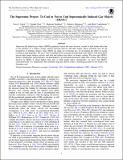The Supersonic Project: To Cool or Not to Cool Supersonically Induced Gas Objects (SIGOs)?
Author(s)
Chiou, Yeou S; Naoz, Smadar; Burkhart, Blakesley; Marinacci, Federico; Vogelsberger, Mark
DownloadPublished version (5.102Mb)
Publisher Policy
Publisher Policy
Article is made available in accordance with the publisher's policy and may be subject to US copyright law. Please refer to the publisher's site for terms of use.
Terms of use
Metadata
Show full item recordAbstract
© 2021. The American Astronomical Society. Supersonically induced gas objects (SIGOs) primarily form in the early universe, outside of dark matter halos due to the presence of a relative stream velocity between baryons and dark matter. These structures may be the progenitors of globular clusters. Since SIGOs are made out of pristine gas, we investigate the effect of atomic cooling on their properties. We run a suite of simulations by using the moving-mesh code AREPO, with and without baryon dark matter relative velocity and with and without the effects of atomic cooling. We show that SIGO's density, temperature, and prolateness are determined by gravitational interactions rather than cooling. The cold gas fraction in SIGOs is much higher than that of dark matter halos. Specifically, we show that SIGO's characteristically low temperature and extremely high gas density forges a nurturing ground for the earliest star formation sites.
Date issued
2021Department
Massachusetts Institute of Technology. Department of Physics; MIT Kavli Institute for Astrophysics and Space ResearchJournal
Astrophysical Journal
Publisher
American Astronomical Society
Citation
Chiou, Yeou S, Naoz, Smadar, Burkhart, Blakesley, Marinacci, Federico and Vogelsberger, Mark. 2021. "The Supersonic Project: To Cool or Not to Cool Supersonically Induced Gas Objects (SIGOs)?." Astrophysical Journal, 906 (1).
Version: Final published version